| MARCH 2024 |
|
4 shows in T˘ky˘ (Kabukiza, Shinbashi Enbuj˘, T˘ky˘ International Forum), 2 in Nagoya (Heisei Nakamuraza), 2 in Ky˘to (Minamiza) and 1 tour (Y˘shun Special Tour)!
|
| Kabukiza (T˘ky˘) |  |
| Dates | 3 ~ 26 March 2024 Sangatsu ďkabuki March Grand Kabuki |
| MatinÚe | |
| Evening |
|
| Casting |
Living National Treasure Onoe Kikugor˘, Living National Treasure Kataoka Nizaemon, Living National Treasure Nakamura Karoku, Living National Treasure Nakamura T˘z˘, Nakamura Jakuemon, Onoe Kikunosuke, Matsumoto K˘shir˘, Nakamura Kaishun, Kataoka Ainosuke, Kataoka Takatar˘, Onoe Sh˘roku, Band˘ Hikosabur˘, Nakamura Matagor˘, Band˘ Yajűr˘, Nakamura Baishi, Band˘ Shingo, Ichikawa Komaz˘, ďtani Tomoemon, Kataoka Ichiz˘, Ichimura Manjir˘, Kawarasaki Gonjűr˘, Sawamura Yoshijir˘, Nakamura Matsue, Matsumoto Kingo, Sawamura S˘nosuke, ďtani Hirotar˘, ďtani Hiromatsu, Nakamura Kash˘, Nakamura Mantar˘, Nakamura Tanenosuke, Nakamura Takanosuke, Nakamura Kichinoj˘, Ichimura Kitsutar˘, Onoe Ushinosuke, Onoe Sakon, Onoe Maholo, Band˘ Kamesabur˘, Nakamura Tamatar˘, Ogawa Hiroharu |
| Comments |
The March Grand Kabuki at the Kabukiza. "Keisei D˘j˘ji" is staged to commemorate the 12th anniversary (13th memorial service) of the passing away of Nakamura Jakuemon IV.
|
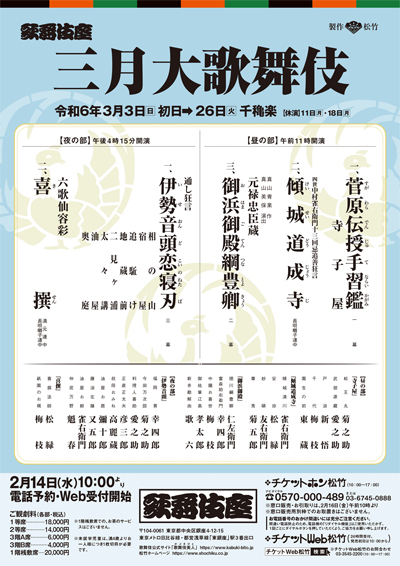 |
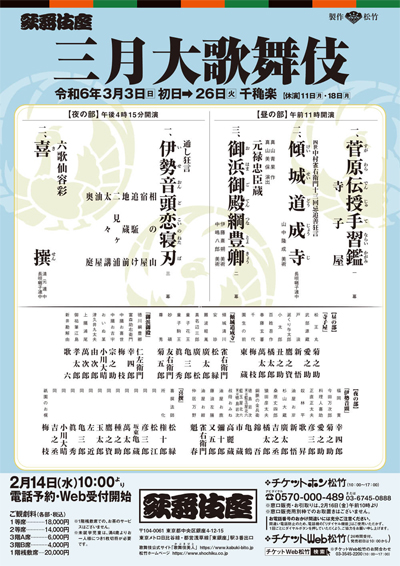 |
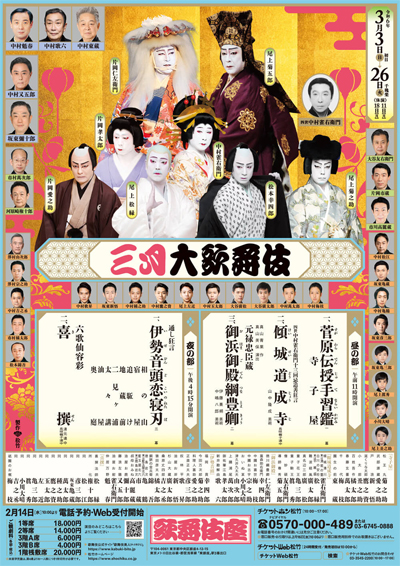 |
| Heisei Nakamuraza (Nagoya) | |
| Dates | 6 ~ 18 March 2024 |
| MatinÚe |
Benten Musume Meo no Shiranami
|
| Evening |
Yoshitsune Senbon Zakura Ninin Fuji Musume |
| Casting |
Nakamura Kankur˘, Nakamura Shichinosuke, Nakamura Senjaku, Kataoka Kamez˘, Nakamura Tsurumatsu, Nakamura Toranosuke, Kitamura Rokur˘ |
| Comments |
The Heisei Nakamuraza is back in Nagoya, within the D˘h˘ High School. These performances commemorate the 12th anniversary (13th memorial service) of the passing away of Nakamura Kanzabur˘ XVIII.
|
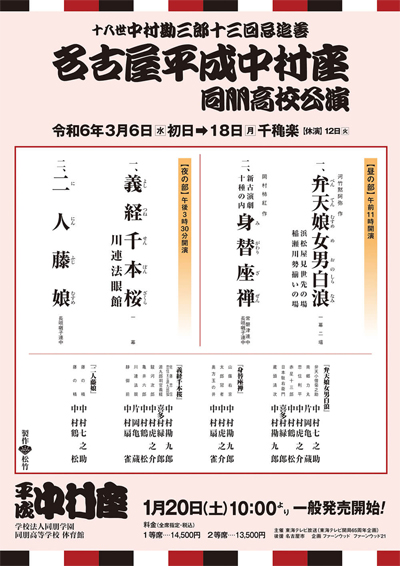 |
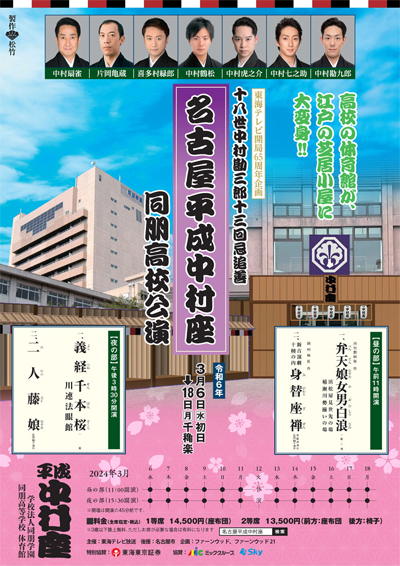 |
|
|
| Dates | 2 ~ 24 March 2024 Sangatsu Hanagata Kabuki March Young Actors Kabuki |
| Matsu Puro ('Pine Tree Program') |
Habakarinagara Tebiki K˘j˘ |
| Sakura Puro ('Cherry Tree Program') |
Habakarinagara Tebiki K˘j˘ |
| Casting |
Onoe Ukon, Nakamura Kazutar˘, Nakamura Hayato, Kamimura Kichiya, Arashi Kitsusabur˘, Kataoka Matsunosuke, Kamimura Kichitar˘, Nakamura Jűjir˘, Kataoka Senju, Kataoka Sentar˘, Kataoka Senjir˘, Onoe Kikusabur˘ |
| Comments |
Young actors performing in Ky˘to at the Minamiza.
|
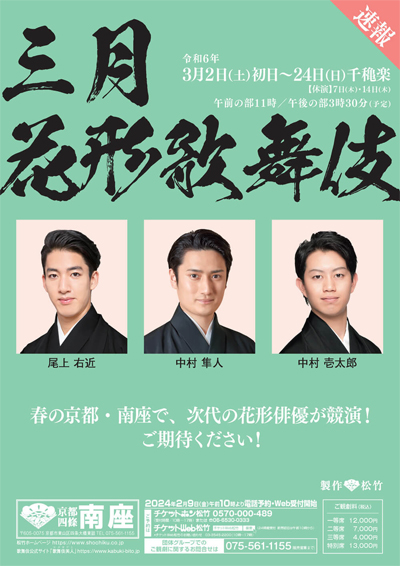 |
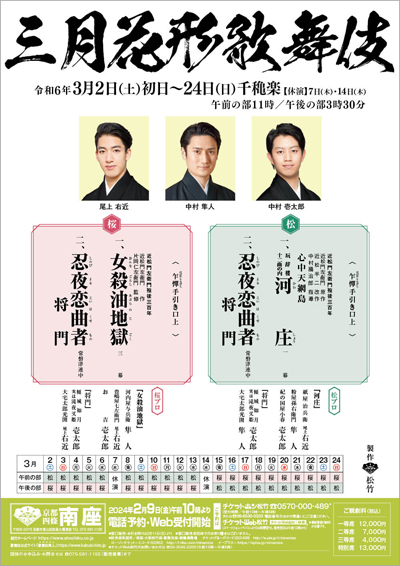 |
 |
| Shinbashi Enbuj˘ (T˘ky˘) |  |
| Dates | 4 February ~ 20 March 2024 |
| Program |
Yamato Takeru |
| Casting |
Ichikawa Chűsha, Nakamura Kinnosuke, Nakamura Hayato, Ichikawa Danko, Ichikawa Monnosuke, Nakamura Yonekichi, Ichikawa En'ya, Ichikawa Emisabur˘, Ichikawa Emiya, Ichikawa Juen, Ichikawa Seiko, Nakamura Fukunosuke, Nakamura Utanosuke, Kashima Noritoshi |
| Comments |
Revival of the famous SűpÔ Kabuki drama "Yamato Takeru", a classic of the Omodakaya guild, in T˘ky˘ at the Shinbashi Enbuj˘. In the absence of Ichikawa Ennosuke, the eponymous role of Yamato Takeru is played by either Nakamura Hayato or Ichikawa Ennosuke III's grandson Ichikawa Danko.
|
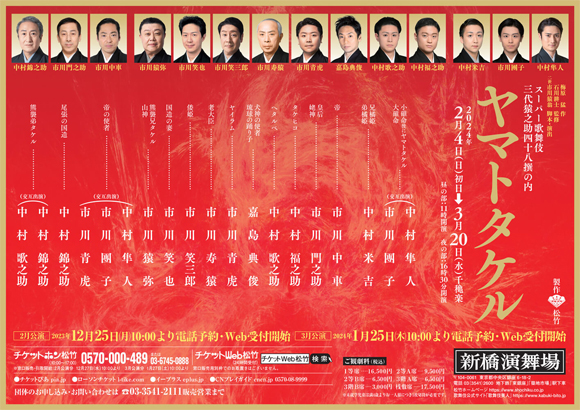 |
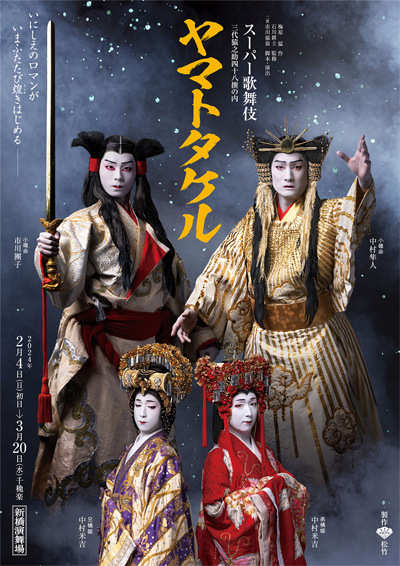 |
| Y˘shun Special Tour | |
| Dates | 26 March ~ 1 April 2024 Y˘shun Kabuki Tokubetsu K˘en The Springtime Kabuki Special Performances |
| Program |
T˘ku K˘nÔ |
| Casting |
Nakamura Kankur˘, Nakamura Shichinosuke, Nakamura Tsurumatsu, Nakamura Kantar˘, Nakamura Ch˘zabur˘ |
| Comments |
A Spring Tour of the Nakamuraya guild with performances in 6 venues.
|
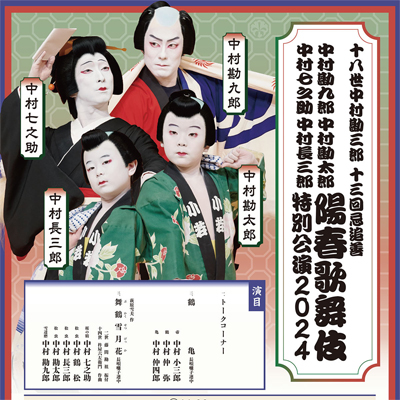 |
| T˘ky˘ International Forum (T˘ky˘) | |
| Dates | 27th March 2024 Nakamura FukusukeĚNakamura Kotar˘ no Kai The Nakamura Fukusuke & Nakamura Kotar˘ Gala |
| Program |
Sanbon no Ito |
| Casting |
Nakamura Fukusuke, Nakamura Kotar˘, Nakamura Kangyoku, Omigawa Chiaki, Matsuda Ry˘, Koshinaka Makoto, Yasuda Momotar˘ |
| Comments |
A 2-performance 1-day gala for Nakamura Fukusuke and his son Nakamura Kotar˘ in T˘ky˘ at the T˘ky˘ International Forum. Nakamura Kangyoku and 4 non-Kabuki actors will be the guest stars of this gala. "Sanbon no Ito" is based on the drama "Sannin Kichisa" and it challenges the members of the audience living today about the meaning of 'living'! |
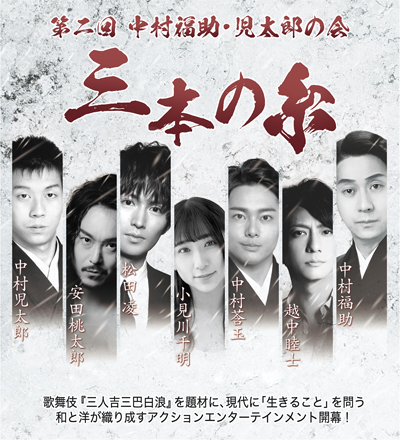 |
|
|
| Contact | Main | Top | Updates | Actors | Plays | Playwrights | Programs | Links | FAQ | Glossary | Chronology | Illustrations | Prints | Characters | Derivatives | Theaters | Coming soon | News |